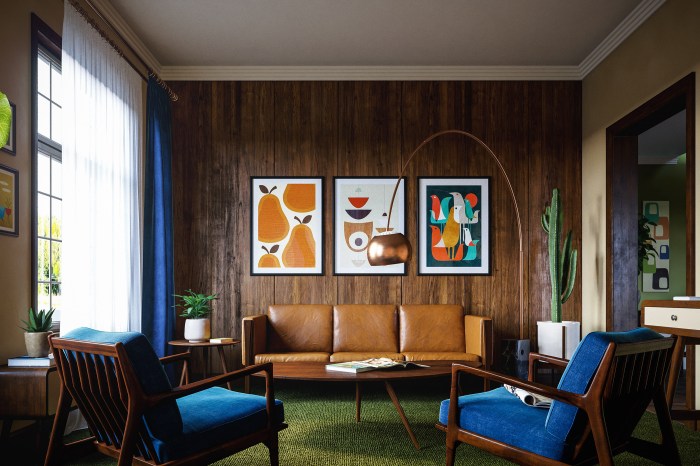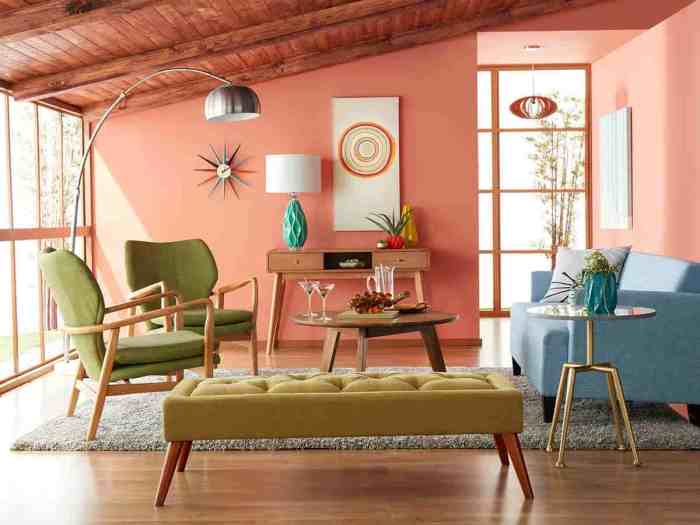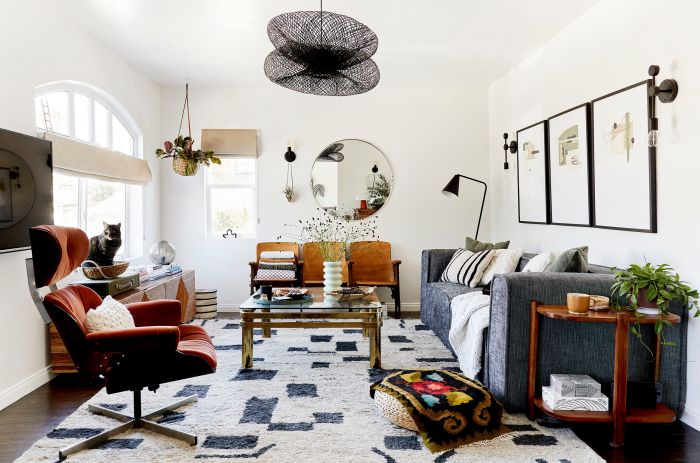Mid Century Modern Wall Decor: Step into a world of sleek lines, organic forms, and vibrant color palettes. This design style, born from the post-war era, continues to captivate with its timeless appeal. We’ll explore the key characteristics, iconic designers, and diverse materials that define this aesthetic, from the warmth of wood to the coolness of glass. Discover how to source authentic pieces, create stunning displays, and incorporate this iconic style into your own home.
From bold geometric prints to subtle nature scenes, Mid Century Modern wall art offers a spectrum of expression. We’ll delve into popular types of decor, including paintings, sculptures, and tapestries, examining the common color palettes and patterns that make this style so recognizable. Learn how to curate a cohesive collection and transform your space with the enduring elegance of Mid Century Modern design.
Defining Mid-Century Modern Wall Decor Style

Mid-Century Modern wall decor, flourishing primarily from the 1930s to the 1960s, represents a distinct aesthetic characterized by its clean lines, functional design, and celebration of organic forms. It’s a style that transcends mere decoration, reflecting a post-war optimism and a focus on simplicity and craftsmanship. This style continues to resonate today, proving its enduring appeal and influence on contemporary design.
Key Characteristics of Mid-Century Modern Wall Decor
Mid-Century Modern wall art and decor are easily recognizable due to several key characteristics. These include the emphasis on geometric shapes, often incorporating organic curves to soften the strict geometry. A preference for natural materials is evident, contrasting with the more ornate styles of previous eras. The overall effect is one of sophisticated simplicity, balancing functionality with artistic expression.
A common thread throughout is a rejection of excessive ornamentation in favor of clean, uncluttered designs.
Iconic Designers and Their Contributions
Several iconic designers significantly shaped the Mid-Century Modern aesthetic. Charles and Ray Eames, for example, contributed significantly with their innovative furniture designs, which often featured plywood and molded plastic, influencing the style’s overall approach to materials and form. Their work often extended to wall-mounted pieces, incorporating the same clean lines and functional design principles seen in their furniture.
Similarly, George Nelson’s innovative clock designs, characterized by their bold geometric forms and playful use of color, are quintessential examples of the style’s playful yet sophisticated nature. Eero Saarinen, known for his iconic Tulip chair, also contributed to the broader aesthetic, influencing the integration of sculptural forms into interior design, which in turn inspired wall decor choices.
Materials Used in Mid-Century Modern Wall Art
The materials used in Mid-Century Modern wall art reflect the era’s emphasis on functionality and honest expression of materials. Wood, often in light tones like teak or walnut, was frequently used, showcasing its natural grain and texture. Metal, particularly brass and chrome, provided sleek accents and structural elements. Glass, especially in the form of colorful panels or decorative objects, added a touch of modern elegance.
These materials were often combined to create visually striking and texturally diverse pieces. The use of these materials reflected a belief in the inherent beauty of the materials themselves, rather than relying on elaborate finishes or ornamentation.
Color Palettes and Patterns
Mid-Century Modern wall decor typically employs a restrained color palette, favoring earth tones, muted greens, yellows, and blues. These colors are often combined with neutrals like beige, cream, or gray, creating a calming and sophisticated atmosphere. Geometric patterns, such as stripes, chevrons, and simple abstract designs, are frequently incorporated, adding visual interest without overwhelming the space. The use of color is intentional, often complementing the natural tones of the materials used, contributing to the overall sense of harmony and balance.
Comparison with Other Design Styles
| Feature | Mid-Century Modern | Art Deco | Minimalist |
|---|---|---|---|
| Overall Aesthetic | Clean lines, organic forms, functionality | Geometric shapes, luxury materials, ornamentation | Simplicity, functionality, reduction to essentials |
| Color Palette | Muted earth tones, neutrals | Rich jewel tones, metallics | Neutral tones, monochromatic schemes |
| Materials | Wood, metal, glass, plastic | Precious metals, exotic woods, glass | Natural materials, often unprocessed |
| Patterns | Geometric, abstract | Geometric, stylized natural forms | Absence of patterns, or very simple ones |
Popular Types of Mid-Century Modern Wall Decor

Mid-Century Modern wall decor encompasses a wide range of artistic expressions reflecting the era’s design principles. Characterized by clean lines, organic forms, and a blend of functionality and artistry, these pieces add a distinct visual appeal to any space. The popularity of specific types and subject matter reveals a fascinating insight into the cultural and artistic trends of the mid-20th century.
Several types of wall decor epitomize the Mid-Century Modern aesthetic. These pieces often share a common thread of simplicity and elegance, yet they offer a diverse range of styles and artistic expressions to suit various tastes and interior design schemes.
Mid-Century Modern Prints and Paintings
Prints and paintings were, and remain, highly popular forms of Mid-Century Modern wall decor. The subject matter often leaned towards abstract expressionism, geometric patterns, and nature-inspired scenes, reflecting the era’s fascination with both natural beauty and the emerging world of abstract thought. Bold colors and graphic designs were frequently employed, creating striking visual impact. Think of the vibrant hues and dynamic compositions found in the works of artists like Josef Albers, whose “Homage to the Square” series exemplifies the period’s exploration of color and form.
Conversely, nature scenes, often depicted in a stylized or simplified manner, offered a counterpoint to the more abstract pieces, reflecting a desire for a connection with the natural world.
Mid-Century Modern Sculptures and Tapestries
Three-dimensional works, such as sculptures and wall-mounted reliefs, also played a significant role in Mid-Century Modern interior design. These pieces often featured organic shapes and materials, reflecting the influence of Scandinavian design and the broader interest in natural forms. Sculptures might incorporate wood, metal, or ceramic, often showcasing clean lines and a minimalist aesthetic. Tapestries, on the other hand, offered a textural counterpoint, frequently incorporating geometric patterns, abstract designs, or stylized representations of nature.
The interplay of color and texture in these pieces added depth and visual interest to the space.
Mid-Century Modern Clocks
Mid-Century Modern clocks often served as both functional and decorative elements. Their designs typically incorporated simple, geometric shapes and clean lines, often using materials like wood, metal, or plastic. The minimalist aesthetic was paramount, and many clocks featured bold numerals or hands against a neutral background. The emphasis was on functionality combined with understated elegance, reflecting the period’s appreciation for streamlined design.
Popular Subject Matter in Mid-Century Modern Wall Art
The subject matter of Mid-Century Modern wall art reflects the era’s broader artistic and cultural trends. Abstract art, with its emphasis on form, color, and composition, was particularly prevalent. Geometric patterns, inspired by both natural forms and mathematical principles, were also widely used, reflecting a fascination with order and structure. Nature scenes, often stylized and simplified, provided a counterpoint to the more abstract works, offering a sense of calm and tranquility.
These depictions of nature often showcased a simplified, almost graphic representation of landscapes, flora, or fauna.
Mid-Century Modern Mood Boards, Mid Century Modern Wall Decor
The versatility of Mid-Century Modern style allows for diverse interpretations. Here are three mood boards showcasing variations in this aesthetic:
- Mood Board 1: Bold and Colorful: This mood board features vibrant, saturated colors in prints and paintings, showcasing abstract expressionism. Elements include a large abstract canvas with bold reds, yellows, and blues; a geometric patterned tapestry in complementary colors; a sculptural wall hanging with bright accents; and a clock with a colorful face.
- Mood Board 2: Muted and Minimalist: This mood board employs a more subdued palette, emphasizing clean lines and simple forms. Elements include a black and white photographic print; a minimalist wood sculpture; a muted-toned geometric tapestry; and a sleek, chrome clock with simple hands and numerals.
- Mood Board 3: Natural and Organic: This mood board highlights natural materials and organic forms. Elements include a nature-inspired print depicting stylized trees or landscapes; a woven wall hanging using natural fibers; a ceramic sculpture with smooth, organic curves; and a wood clock with a simple, unadorned design.
Popular Mid-Century Modern Artists
Several artists significantly contributed to the visual language of Mid-Century Modern design, and their work frequently appears as wall decor. These artists include, but are not limited to, Alexander Calder (known for his mobiles), Josef Albers (famous for his “Homage to the Square” series), and Charles and Ray Eames (whose designs extended beyond furniture to include prints and graphics).
Other notable artists whose work often graces Mid-Century Modern interiors include Paul McCobb, George Nelson, and Isamu Noguchi, whose diverse talents contributed to the era’s distinctive aesthetic. Their work reflects the period’s exploration of form, function, and the interplay of color and texture.
The Impact and Evolution of Mid-Century Modern Wall Decor: Mid Century Modern Wall Decor

Mid-Century Modern wall decor, flourishing primarily from the 1930s to the 1960s, wasn’t merely a stylistic choice; it was a reflection of profound societal shifts and technological advancements. Its impact extended beyond aesthetics, shaping how people lived and perceived their homes. This evolution continues to resonate today, influencing contemporary design trends.The post-World War II era witnessed a surge in optimism and a desire for a clean break from the past.
This cultural climate, coupled with advancements in manufacturing and materials, fueled the rise of Mid-Century Modern design. The emphasis on functionality, affordability, and mass production made the style accessible to a wider population than ever before. This accessibility was crucial to the style’s impact, democratizing good design and creating a sense of shared aesthetic. Influences from Bauhaus, Scandinavian design, and even Japanese aesthetics contributed to the style’s unique blend of simplicity and elegance.
Mid-Century Modern Wall Decor’s Reflection of Post-War Optimism
The clean lines, simple forms, and vibrant colors characteristic of Mid-Century Modern wall art and decor directly reflected the post-war optimism and a desire for a more functional, less ornate aesthetic. The rejection of overly elaborate Victorian styles was a conscious move toward a more streamlined and efficient lifestyle, mirroring the technological advancements of the time. This is evident in the popularity of geometric patterns, abstract art, and the use of new materials like plastics and laminates.
For example, the widespread use of brightly colored textiles, often featuring bold geometric patterns, signified a departure from the muted tones and intricate designs of previous eras. These vibrant colors and patterns represented a sense of hope and renewal.
Evolution and Adaptation of Mid-Century Modern Wall Decor
The style didn’t remain static. As societal values and technological capabilities changed, so did Mid-Century Modern wall decor. The early years saw a focus on functionality and simplicity, with an emphasis on natural materials like wood and textiles. Later iterations incorporated more bold colors and patterns, reflecting a growing sense of experimentation and freedom of expression. The introduction of new materials, such as fiberglass and acrylics, opened up new possibilities for sculptural wall art and decorative objects.
The Space Race also influenced the style, with designs incorporating futuristic elements and bold geometric forms. For instance, the iconic Sputnik chandelier, with its radiating arms, became a symbol of this era’s technological aspirations and its impact on design.
Comparison of Early and Contemporary Mid-Century Modern Wall Decor
Early Mid-Century Modern wall decor emphasized functionality and simplicity, often featuring natural materials and understated color palettes. Contemporary interpretations, while retaining the core principles of the style, often incorporate more diverse materials and bolder color schemes. Early examples might feature simple wood paneling or geometric textile hangings, while contemporary versions might incorporate metallic accents, vibrant colors, and even digital prints inspired by the original aesthetic.
However, both early and contemporary pieces share a commitment to clean lines, functional design, and a focus on creating a sense of calm and order. The evolution lies not in a radical departure from the original principles, but rather in a refinement and adaptation to modern sensibilities and manufacturing techniques.
Mid-Century Modern Wall Decor and Shifting Social Values
Mid-Century Modern wall decor reflects several significant social shifts. The increasing prominence of women in the workforce and the rise of the nuclear family are reflected in designs that emphasized functionality and ease of maintenance. The move towards suburban living is also apparent, with designs that sought to create a sense of openness and connection with nature. The growing awareness of environmental concerns, while not as prominent in the original era, is now influencing contemporary interpretations, with a renewed focus on sustainable materials and production methods.
The rise of pop art and its influence on mass culture can also be seen in the increasingly bold and graphic nature of some contemporary Mid-Century Modern-inspired wall art. The original style’s focus on accessible design and functionality continues to resonate, particularly as consumers seek out pieces that are both stylish and practical.
Mid Century Modern wall decor transcends mere decoration; it’s a statement of refined taste and appreciation for design history. By understanding its core principles and exploring the diverse options available, you can curate a space that reflects your personal style while embracing the enduring legacy of this iconic aesthetic. Whether you’re an avid collector or simply seeking to add a touch of mid-century charm to your home, the possibilities are as limitless as your imagination.